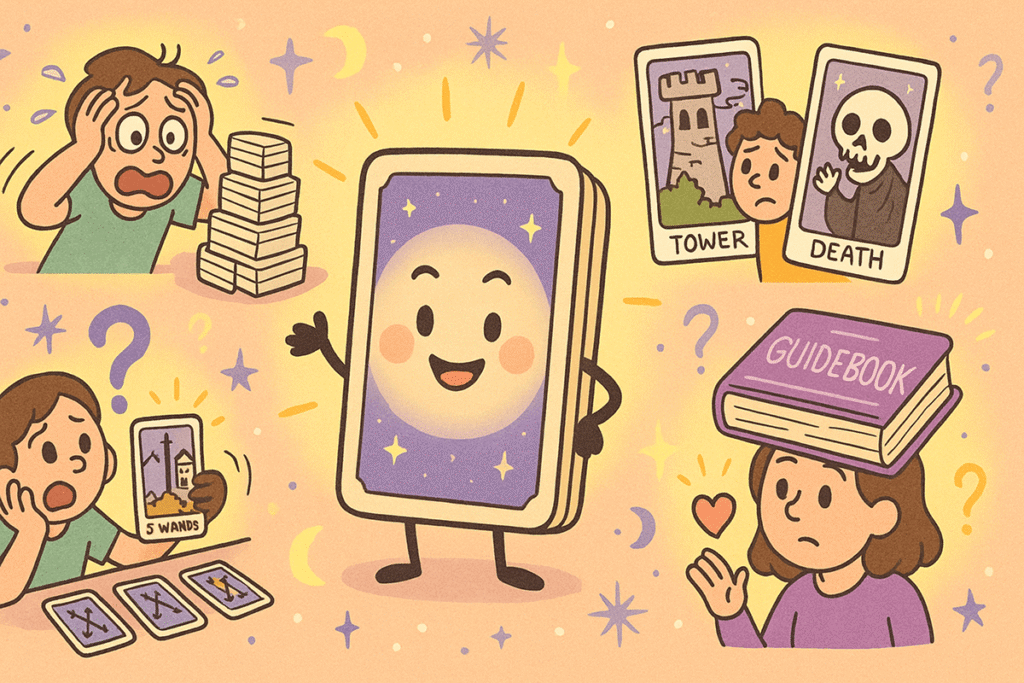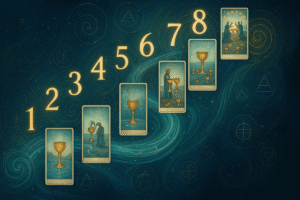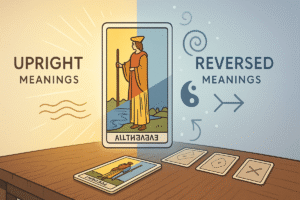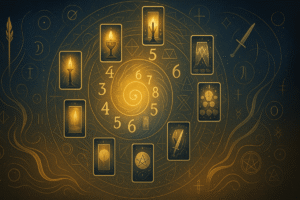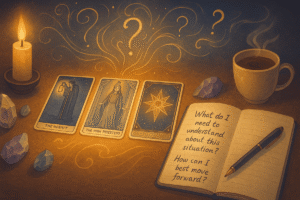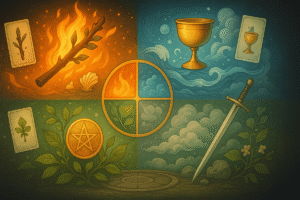Table of Contents
Starting your tarot journey can feel both exciting and overwhelming. I remember my first deck sitting on my nightstand for weeks because I felt intimidated by all those intricate images and mysterious symbols. Perhaps you’ve experienced something similar, or maybe you’ve already begun but noticed yourself falling into certain patterns that don’t quite feel right.
The beautiful thing about tarot is that there’s no single “correct” way to approach it. However, there are some common stumbling blocks that many new readers encounter. These aren’t really mistakes in the traditional sense, but rather natural learning experiences that can actually become valuable parts of your growth process once you recognize them.
Let’s explore some of these patterns together and consider how you might gently shift your approach to create a more fulfilling and authentic practice.
Trying to Memorize Every Card Meaning at Once
When you first open a tarot guidebook, it’s easy to feel like you need to memorize all 78 card meanings before you can even attempt a reading. This approach, while well-intentioned, often leads to frustration and can actually disconnect you from your intuitive responses to the cards.
I think many of us have been there, sitting with flashcards or frantically flipping through pages during a reading. But here’s something interesting to consider: what if the real wisdom isn’t in memorizing someone else’s interpretation, but in developing your own relationship with each card?
Instead of trying to absorb everything at once, you might find it more rewarding to work with just one card at a time. Spend a few days carrying a single card with you, noticing what thoughts or feelings arise when you look at it. What details catch your eye? How do the colors affect your mood? What story do you see unfolding in the imagery?
This slower approach allows you to build genuine familiarity with each card’s energy. You’ll likely find that your personal associations become just as valuable, if not more so, than the traditional meanings found in books. After all, the most powerful readings often come from that quiet inner knowing rather than memorized definitions.
Perhaps start with the cards that immediately draw you in or, conversely, the ones that make you feel slightly uncomfortable. These strong reactions often signal where your most meaningful learning opportunities lie.
Fearing the So Called Negative Cards
Death. The Tower. The Devil. Even seasoned readers sometimes feel a little flutter of anxiety when these cards appear. For beginners, encountering these seemingly ominous images can trigger worry or fear about what they might represent in their lives.
This reaction is completely natural and understandable. The imagery on these cards can be striking, even unsettling at first glance. But what if we considered these cards not as harbingers of doom, but as teachers offering important insights about change, release, and transformation?
The Death card, for instance, rarely refers to physical death. More often, it invites reflection on what aspects of your life might be ready for transformation. What old patterns or situations have you outgrown? Where might you be clinging to something that no longer serves you?
The Tower suggests sudden change or revelation, but it also points to the liberation that can come from releasing false foundations. What illusions might you be ready to let go of? Where in your life could some healthy disruption actually create space for something better?
I’ve found that reframing these cards as invitations for self-reflection rather than predictions can completely change your relationship with them. Instead of asking “What terrible thing will happen?” you might ask “What am I being invited to examine more closely in my life right now?”
When these cards appear, perhaps take a moment to breathe and consider what wisdom they might offer rather than immediately assuming the worst. You might be surprised by the valuable insights they provide when approached with curiosity rather than fear.
Asking the Same Question Over and Over
Have you ever done a reading, felt unsatisfied with the answer, and immediately shuffled the cards to ask again? This is such a common experience, especially when we’re hoping for a different outcome or clearer guidance on something we’re anxious about.
While it’s natural to want clarity, repeatedly asking the same question can actually muddy the waters rather than clear them. It’s a bit like asking a friend for advice, not liking their response, and then immediately asking the same question again. Eventually, the conversation becomes less helpful and more frustrating for everyone involved.
When you find yourself tempted to re-ask a question, it might be worth pausing to consider what’s driving that urge. Are you seeking reassurance? Trying to avoid accepting something you already know? Looking for permission to make a choice you’ve already made in your heart?
Sometimes the cards give us exactly the message we need, even if it’s not the one we wanted. The challenge lies in sitting with that discomfort and exploring what it might be trying to teach us.
If you do feel called to explore a topic further, consider reframing your question rather than repeating it exactly. Instead of asking “Should I take this job?” three times in a row, you might follow up with “What do I need to consider about this opportunity?” or “How can I best prepare for this decision?”
This approach honors your desire for deeper understanding while maintaining the integrity of your reading practice. It also encourages you to engage more thoughtfully with the guidance you receive.
Ignoring Your Intuition in Favor of the Guidebook
Guidebooks are wonderful resources, especially when you’re starting out. They provide context, traditional meanings, and helpful frameworks for understanding the cards. However, I’ve noticed that some readers become so dependent on external interpretations that they stop trusting their own instincts entirely.
Your first reaction to a card often contains valuable information. That flutter of excitement, moment of recognition, or flash of insight that occurs before you even consult your guidebook? That’s your intuition speaking, and it deserves to be heard.
Perhaps try this experiment: before reaching for your guidebook during a reading, spend a few moments simply observing each card. What do you notice? What feelings arise? What thoughts or memories surface? What story do you see in the imagery?
These initial impressions aren’t random; they’re your psyche responding to the symbolic language of the cards in a way that’s personally meaningful to you. The guidebook can certainly enhance and expand upon these insights, but it shouldn’t replace them entirely.
I think many people worry that their personal interpretations aren’t “correct” or sophisticated enough. But tarot has always been a deeply personal practice, and your unique perspective is actually one of your greatest assets as a reader. The cards speak differently to each person, and your individual lens is what makes your readings authentic and relevant to your life.
Try treating the guidebook as a conversation partner rather than an authority. Let it dialogue with your intuition rather than override it completely.
Expecting Immediate Mastery and Perfect Clarity
In our fast-paced world, it’s easy to expect that we should master new skills quickly and efficiently. With tarot, this expectation can lead to disappointment when readings don’t immediately provide crystal-clear guidance or when card meanings don’t instantly click into place.
Tarot is more like learning a new language than memorizing facts. It takes time to become fluent, and even experienced readers continue to discover new layers of meaning in familiar cards. The journey itself is part of the value, not something to rush through on your way to expertise.
I’ve found that some of my most meaningful insights have come from readings that initially seemed confusing or unclear. Sometimes the message becomes apparent days or weeks later when life circumstances provide context. Other times, the act of sitting with uncertainty itself becomes the lesson.
Consider embracing the beginner’s mind rather than pushing yourself toward premature mastery. What would happen if you approached each reading with curiosity rather than pressure to “get it right”? How might your practice shift if you viewed confusion as an opportunity for deeper exploration rather than a sign of failure?
There’s something beautiful about allowing your understanding to unfold naturally over time. Each reading builds upon the last, creating a rich tapestry of personal experience and insight that no guidebook could ever provide.
Perhaps the goal isn’t to achieve perfect clarity, but to develop a more nuanced relationship with mystery and intuition. In a world that often demands immediate answers, tarot invites us to sit comfortably with questions and allow wisdom to emerge in its own time.
Growing Through Gentle Practice
As you continue developing your tarot practice, remember that every reader has walked this path of discovery. Those moments of confusion, those readings that don’t seem to make sense, those cards that challenge your preconceptions? They’re all part of the rich learning process.
The most fulfilling tarot practice often emerges not from following rigid rules or achieving perfect technique, but from approaching the cards with openness, curiosity, and self-compassion. Each reading offers an opportunity for reflection and growth, regardless of whether it provides the specific answers you were seeking.
Trust your journey. Trust your intuition. And most importantly, trust that your unique relationship with the cards will continue to deepen and evolve as long as you approach it with patience and genuine curiosity about what they might have to teach you.
Frequently Asked Questions
How long should I wait before asking the same question again?
If you’re tempted to repeat a reading because you didn’t like the answer, wait at least two to four weeks before revisiting the same question. This gives you time to reflect on the guidance you received and allows circumstances to shift naturally. Instead of asking the exact same question multiple times, consider reframing it to explore different angles of the situation.
Is it normal to feel overwhelmed when starting tarot?
Absolutely. Most beginners feel intimidated by the 78 cards and all their meanings. This feeling is a natural part of the learning process, not a sign that tarot isn’t for you. Rather than pressuring yourself to master everything quickly, focus on building your practice one card at a time and remember that developing fluency with tarot can take months or even years.
Should I only use my guidebook for card meanings?
Your guidebook is a helpful reference tool, but it shouldn’t be your only source of interpretation. The most meaningful readings often come from balancing traditional meanings with your personal intuition and observations. Try looking at each card first and noting your immediate reactions before consulting the guidebook, then see how both perspectives can work together.
Can I read tarot for myself or do I need someone else?
You can definitely read tarot for yourself, and it’s actually one of the best ways to learn. However, reading for yourself works best when you’re in a relatively calm, open state of mind. When you’re feeling highly emotional or anxious about a situation, your readings may become clouded by what you hope to see rather than what the cards are actually showing you.

